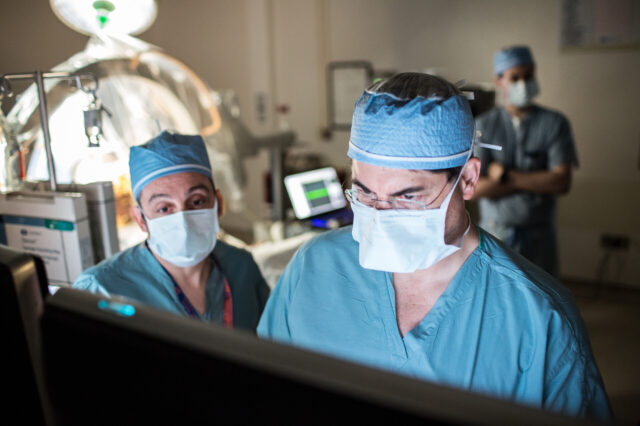Dual-lead deep brain stimulation shows benefit in treating severe MS tremor

Multiple sclerosis patients with severe, treatment-resistant tremors may gain marked improvement from deep brain stimulation surgery, or DBS, in which two DBS leads are implanted in the side of the brain opposite the tremor, according to a new study by University of Florida researchers published in the latest edition of The Lancet Neurology.
The research team from the Evelyn F. and William L. McKnight Brain Institute of the University of Florida found that eight of the 12 patients in the study experienced a significant reduction in tremors for at least six months after the deep brain stimulation leads were turned on.
Tremor is a common symptom of multiple sclerosis, with up to half of MS patients developing severe or debilitating tremors, typically in the upper extremities.
“Traditionally, MS tremor hasn’t responded as well to deep brain stimulation as other types of tremor, such as in Parkinson’s disease or essential tremor, which respond really well to DBS,” said Seth Oliveria, M.D., Ph.D., an assistant professor in UF’s Lillian S. Wells department of neurosurgery and lead author on the paper. “There have been a lot of trials over the years and in general, multiple sclerosis tremor hasn’t responded at all to deep brain stimulation or it has responded only temporarily and then come back.”
The need to find treatments for MS tremor cannot be overstated.
“MS tremor is surprisingly common in multiple sclerosis patients worldwide, and there is a pressing need to develop a meaningful therapy for this symptom that is disabling and distressing for the majority of patients who shake,” said Augusto Miravalle, M.D., an associate professor of neurology and chief of UF’s multiple sclerosis division, who was not involved with this study.
Deep brain stimulation is a well-established treatment involving surgical implantation of a battery-operated medical device to deliver therapeutic electrical stimulation to targeted areas in the brain that control movement.
The new UF study is significant in two ways: first, the focus on MS tremor, and second, that surgeons implanted two — rather than one as is customary — DBS leads in the same side of the brain. The two leads, with four electrode contacts on each, were implanted parallel to one another in neighboring parts of the thalamus.
UF neurosurgery professor Kelly Foote, M.D., along with his neurology partner Michael Okun, M.D., chair of neurology, developed the new, patented technique for implanting and securing two DBS leads in the same side of the brain in order to modulate multiple nodes in a malfunctioning brain network.
In pioneering the use of the new technique, “we thought MS tremor would be a good test bed for the new dual-lead DBS strategy because it is severely debilitating and it tends to respond poorly to all existing therapies including traditional single-lead thalamic DBS,” said Foote, the senior author of the paper. “By implanting two DBS leads in the thalamus on the same side of the brain, we were able to stimulate a larger volume of tremor-causing brain tissue, including both cerebellar and pallidal circuits known to be involved in the generation of severe tremor. With dual-lead thalamic DBS, we managed to provide most of these severely affected patients with significant tremor suppression for at least six months.”
In the randomized controlled trial, each patient had two leads implanted during surgery, but only one of the two was initially activated. Both leads then were turned on for the second part of the study.
The promising results of this study in severe MS tremor provide hope that dual-lead DBS might be effective for other difficult-to-control tremor disorders, such as in severe Parkinson’s tremor or severe essential tremor, Oliveria said.
“This might be an effective new strategy for treating people with more severe problems,” he said.
In the current study, three patients who did not respond to treatment either were experiencing progression of MS or had severe ataxia, a lack of muscle control or coordination of voluntary movements that can result from damage to the cerebellum caused by multiple sclerosis or other disorders. One of the four patients considered non-responders developed an infection and could not continue in the study.
Potential side effects of the new dual-lead thalamic DBS procedure are similar to those seen in traditional single-lead DBS and can include adverse effects on speech, swallowing, walking or even cognitive function or moods.
“It’s a novel technique and it’s not that much more difficult in terms of technical challenge than traditional DBS,” Oliveria said. “Our findings here suggest that by stimulating multiple locations in the brain, we can get better control over abnormally functioning neural networks.”
The logical next step will be larger studies of patients with MS tremor or other severe tremor disorders to demonstrate whether the technique is widely effective.
The study, titled “Safety and efficacy of dual lead thalamic deep brain stimulation for treatment-refractory multiple sclerosis tremor: a randomized, single-center pilot trial,” was funded by the National Institutes of Health, the Cathy Donnellan/Albert E. and Birdie W. Einstein Fund of the University of Florida College of Medicine, and the University of Florida INFORM database.
About the author
